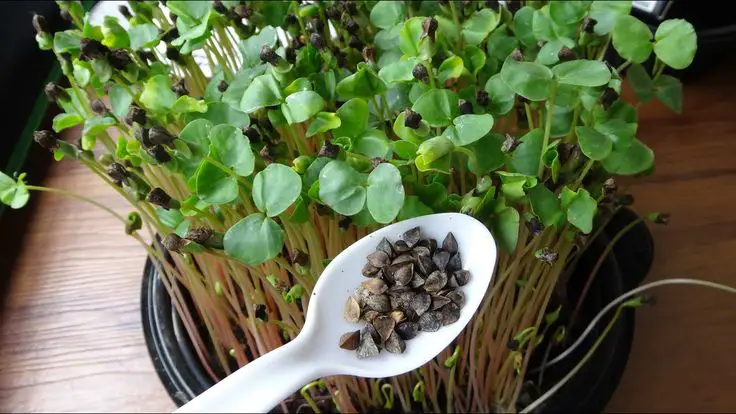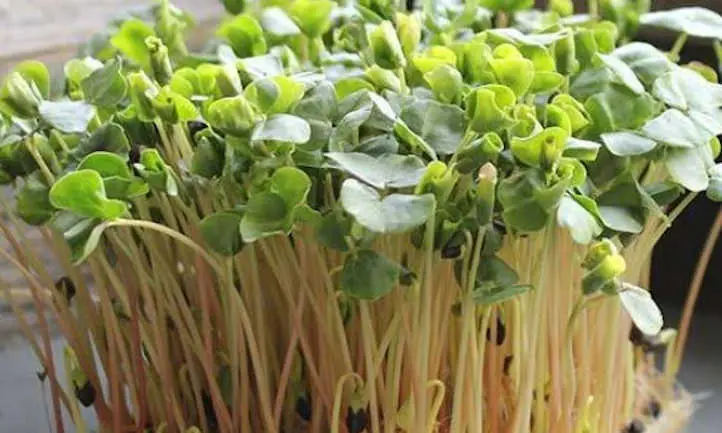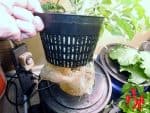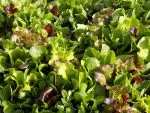This post contains affiliate links. If you buy something from one of our links we may earn a commission. Thanks

Would you like to know how to grow buckwheat microgreens? We will show you how to do it in just seven easy steps. It’s easy to grow even for beginners.
To grow Buckwheat Microgreens, begin by soaking the seeds overnight in purified water. The next day, spread the moistened seeds evenly over a shallow container filled with potting soil or compost mix and mist lightly with water.
Place the container under indirect sunlight, misting the soil daily. Within 2-3 days, you should see sprouts emerging. Once they reach 2 to 3 inches in length, usually in 7 to 14 days from planting, they are ready to be harvested. Cut the greens just above soil level and enjoy them raw or lightly cooked in various dishes.
Buckwheat microgreens are a great source of protein, fiber, vitamins, and minerals, and they taste great too. Sometimes they are called buckwheat lettuce too.
So if you’re ready to start growing your own microgreens, keep reading for instructions on how to do it.
How To Use Buckwheat Microgreens Seeds
Growing microgreens is a fast and easy way to enjoy fresh, nutritious greens in the comfort of your own home.
A great option for growing microgreens is buckwheat microgreen seeds even if you are growing for the first time.
All you need to do is start by soaking buckwheat seeds overnight in a glass of purified water.

Soaking your seeds will soften the seed hulls and make it easier for them to fall off when your buckwheat starts to sprout.
Once soaked, spread the moistened seeds evenly over a shallow container filled with potting soil or compost mix and lightly mist with water.
Keep the container covered under indirect sunlight and spray the soil once or twice a day until it starts germinating – within two or three days you should see sprouts poking through the surface.
When harvesting your buckwheat plants, cut the greens just above where they emerge from the soil and enjoy them raw on salads and sandwiches – or lightly cooked in stir-fries and other dishes.
Buckwheat microgreens can provide a delicious boost of nutrition to any meal plan.
Other Uses
Buckwheat is often ground into buckwheat flour which is a popular ingredient in pancakes. The grain is also cooked and called kasha in some Slavic countries.
How To Grow Buckwheat Microgreens In 7 Easy Steps For Beginners:
Buckwheat is very easy to grow and because it is many farmers use it as a cover crop. It is not a cool weather crop and is often sown in summer.

 1. The first step is to purchase quality buckwheat microgreen seeds from a reliable source. Make sure the type of seed is certified organic and non-GMO if possible.
1. The first step is to purchase quality buckwheat microgreen seeds from a reliable source. Make sure the type of seed is certified organic and non-GMO if possible.
2. Place the buckwheat seeds inside a shallow growing tray or container filled with growing media such as coconut coir, potting soil, or seed starting mix.
If you want to avoid soil you can grow buckwheat microgreens without a growing medium like soil by using coco grow mats instead.
 You want to use a tray with drainage holes for the best results. Your media goes into that tray and a tray with no holes is used to bottom water whatever growing medium you choose.
You want to use a tray with drainage holes for the best results. Your media goes into that tray and a tray with no holes is used to bottom water whatever growing medium you choose.
3. Place the tray or container in an area with plenty of sunshine, such as a sunny windowsill. Make sure they get 4-6 hours of direct sunlight. Another good option is to use LED grow lights if the lighting is poor.
 4. Water your buckwheat microgreens regularly and make sure the soil stays moist, but not soggy. Use a spray bottle to mist your seedlings.
4. Water your buckwheat microgreens regularly and make sure the soil stays moist, but not soggy. Use a spray bottle to mist your seedlings.
5. Monitor for any pests or diseases that may affect your crop, and take action immediately if any are found.
Overwatering is the most common problem so go easy and use a misting bottle so you don’t give them too much water.
6. Harvesting buckwheat microgreens starts when they are about 2 to 3 inches in length and have their first leaves. This will take approximately 7 to 14 days from planting.
7. Harvest Time! Enjoy your freshly harvested buckwheat microgreens. You can eat them raw, add them to salads, or use them as a garnish for other dishes.
Remember they have a short shelf life. Don’t store them in an airtight container they need ventilation. Here is an article about how to store microgreens.
Tips
Growing buckwheat microgreens is an easy and rewarding endeavor that anyone can do with just a few steps. Here are some tips:
• Buckwheat microgreens generally require moderate to high levels of light to grow properly.
• They should be grown in a location that receives at least 4 hours of sunlight, or under artificial grow lights. They will not do well in low-light conditions.
• To ensure that your buckwheat microgreens receive enough light, it is important to place them in a sunny location or provide them with artificial grow lights.
• If using grow lights, make sure to keep them at a distance recommended by the grow light’s manufacturer and provide them with 12-16 hours of light per day.
• It is also important to monitor the temperature and humidity levels in the growing environment to ensure that the microgreens are receiving the optimal conditions for growth.
• Maintaining proper temperature and humidity levels is a good thing that will help to ensure that the microgreens grow healthy and strong.
Buckwheat Microgreens Benefits
According to NPR: The researchers looked at four groups of vitamins and other phytochemicals – including vitamin C, vitamin E, and beta carotene — in 25 varieties of microgreens. They found that leaves from almost all of the microgreens had four to six times more nutrients than the mature leaves of the same plant.
What Are The Benefits Of Eating Buckwheat Microgreens?
Disclaimer: I am not a physician and don’t play one on TV either. The material on this site is not a substitute for professional medical advice, diagnosis, or treatment. Always seek a physician’s advice before using any information you find on this website to treat or prevent any condition.
Buckwheat is a nutritious grain-like seed that is high in antioxidants, vitamins, and minerals. Buckwheat greens are also a good source of fiber and protein and is low in calories and fat. Here are some specific health benefits of eating buckwheat:
May help lower cholesterol: Buckwheat contains compounds called rutin and quercetin, which have been shown to help lower cholesterol levels and improve heart health.
May help regulate blood sugar: Buckwheat has a low glycemic index, which means it is absorbed slowly by the body and does not cause rapid spikes in blood sugar levels. This can be helpful for people with diabetes or those at risk of developing diabetes.
May help with weight loss: Because it is low in calories and high in fiber, buckwheat may help you feel full and satisfied, which can help with weight loss.
May improve digestion: The high fiber content of buckwheat can help improve digestion and prevent constipation.
May support bone health: Buckwheat is a good source of minerals like magnesium, which is important for maintaining healthy bones.
Overall, eating buckwheat can be a nutritious and delicious way to support your overall health and well-being.
Buckwheat is a highly nutritious whole grain that many people consider to be a superfood. Among its health benefits, buckwheat may improve heart health, promote weight loss, and help manage diabetes.Buckwheat is a good source of protein, fiber, and energy.
https://www.medicalnewstoday.com/articles/325042
Why Eat Buckwheat Microgreens?
Buckwheat microgreens have gained popularity in recent years due to their health benefits.
Microgreens are the young and immature version of established plants and are harvested 1-3 weeks after germination.
Among all microgreens, buckwheat microgreens are one that stands out because it is packed with nutrition and can be added to a variety of dishes, sweet or savory.
Buckwheat microgreens are said to contain high amounts of proteins, vitamins, minerals, and antioxidants, thus bringing multiple health benefits.
More specifically, these microgreens may help boost the immune system, reduce blood pressure levels and improve digestion amongst other things.
Eating buckwheat microgreens as part of a regular diet may improve overall wellness.
Buckwheat Microgreens Nutrition
Buckwheat microgreens are a type of edible green plant that is harvested when the plant is very young, typically within 7-14 days after germination.
They are a good source of nutrients and contain a variety of vitamins, minerals, and phytochemicals.
What Is The Nutritional Value 0f Buckwheat Microgreens?
One serving (about 1 cup) of raw buckwheat microgreens contains approximately:
- 25 calories
- 1 gram of protein
- 5 grams of carbohydrate
- 1 gram of fiber
- 0 grams of fat
Buckwheat Microgreens Advantages
Buckwheat microgreens are a good source of several vitamins and minerals, including vitamin C, vitamin K, vitamin E, and manganese.
They also contain a variety of phytochemicals, including flavonoids and phenols, which have been shown to have antioxidant and anti-inflammatory properties.
Buckwheat microgreens are rapidly becoming a popular superfood for health-conscious individuals.
Especially known for their balanced nutritional profile, buckwheat microgreens consist of carbohydrates, vitamins, minerals, antioxidants, and dietary fiber that help to provide the body with essential nutrition.
On top of that, they contain high amounts of magnesium and polyphenols which can aid in boosting energy levels and reducing the risk of chronic conditions such as heart disease.
With all these impressive health benefits, it’s easy to understand why buckwheat microgreens are quickly becoming a staple in many diets.
Buckwheat microgreens nutrition offers an incredibly high yield of nutrition, packed into a small package. These leafy, edible sprouts are loaded with vitamins, minerals, fiber, and an abundance of antioxidants.
Cultivation of buckwheat microgreens requires minimal growth medium and is often grown indoors on soil-free media or in containers.
A single four-week harvest can provide up to 400 times the amount of calcium that you would get from eating the same amount of fully mature buckwheat plant.
What’s more, buckwheat microgreens are incredibly easy to prepare and can be added to smoothies, salads, sandwiches, soups, and stir-fries for a vitamin and mineral boost.
What Do Buckwheat Microgreens Taste Like?
Buckwheat microgreens have a mild and nutty flavor, similar to that of spinach. They are versatile enough to be eaten raw or lightly cooked, making them the perfect addition to any dish.
When consumed raw, buckwheat microgreens will provide a crunchy texture accompanied by its subtle aromatic and earthy taste.
If you prefer your greens cooked, lightly sautéing in butter or olive oil will result in a soft and succulent side dish.
By following the 7 simple steps in this article, you can easily grow your own nutritious buckwheat microgreens at home in no time.
With their impressive nutrient profile and great taste, these tiny greens are sure to become an essential part of your diet.
So why not start growing your own buckwheat microgreens today to reap the rewards of their many health benefits?
How Do You Use Buckwheat Microgreens?
Buckwheat microgreens can be used in a variety of ways in the kitchen. Here are a few ideas for incorporating them into your meals:
- Salad: Add a handful of buckwheat microgreens to your favorite salad for a nutritional boost.
- Sandwiches and wraps: Use buckwheat microgreens as a topping for sandwiches and wraps in place of lettuce or spinach.
- Smoothies: Blend a handful of buckwheat microgreens into your smoothies for a nutrient-rich boost.
- Juice: Mix buckwheat microgreens into your homemade juice recipes for added nutrition.
- Stir-fries: Add a handful of buckwheat microgreens to stir-fries or other cooked dishes during the last minute of cooking for a burst of flavor and nutrients.
It’s important to remember to wash buckwheat microgreens thoroughly before using them, as they can contain dirt and debris from the growing process.
FAQs
How long does it take buckwheat to sprout?
It usually takes about 3-5 days for buckwheat to sprout. The time it takes for the seeds to sprout can vary depending on the temperature and humidity of the environment in which they are sprouting.
It is important to keep the soil moist and the seeds at a consistent temperature in order to encourage sprouting.
Use a misting bottle to water your seeds as top watering can move them around or uncover them.
You can expect to see the first sprouts within 3-5 days, but it may take longer for the sprouts to fully mature.
How hard is it to grow buckwheat microgreens?
Growing buckwheat microgreens is generally easy and can be done in a small space, such as on a windowsill or in a small container. Here are the basic steps for growing buckwheat microgreens:
• Start by soaking the buckwheat seeds in water for 4-6 hours. This will help to soften the seeds and encourage them to sprout more quickly.
• After soaking, drain the seeds and spread them evenly over a tray or container filled with potting soil or seed-starting mix.
• Water the seeds gently, making sure not to disturb the soil too much. Keep the soil moist, but not soggy, as the seeds germinate.
• Place the tray or container in a warm, sunny location and cover it with a plastic bag or a lid to create a humid environment.
• Check on the seeds every day and water as needed to keep the soil moist. You should see the first sprouts within a few days. Remove any cover you used.
• Once the microgreens are about 2-3 inches tall and have their first set of true leaves they are ready to be harvested.
• Simply cut the greens at soil level with scissors and enjoy them in salads, sandwiches, or as a garnish.
Overall, growing buckwheat microgreens is a relatively easy and low-maintenance process, making it a great option for beginners or those with limited space.
How do you remove buckwheat hulls from microgreens?
If you soak your seeds and keep them misted during germination most hulls will fall off by themselves.
To remove the buckwheat hulls that didn’t fall off from the microgreens, you can try giving them a good rinse of the microgreens in a bowl of cold water.
The hulls should come off easily as you gently agitate the microgreens in the water. You can also use your fingers to gently rub the microgreens to loosen any remaining hulls.
Once the hulls have been removed, you can gently pat the microgreens dry with a paper towel or a clean dish towel. Alternatively, you can spin the microgreens in a salad spinner to remove any excess water.
Can you grow buckwheat as microgreens?
Yes, buckwheat is often grown as microgreens. Microgreens are small, tender seedlings that are harvested when they are just a few inches tall, usually within 7-14 days of germination.
They are typically grown in soil or a soil-like medium and are harvested by cutting the greens at the soil level with scissors.
Buckwheat microgreens are a nutritious and flavorful addition to salads, sandwiches, and other dishes. They have a slightly sweet, nutty flavor and are high in antioxidants, vitamins, and minerals. They are also relatively easy to grow and can be grown in a small space, such as on a windowsill or in a container.
Can you eat raw buckwheat sprouts?
Yes, raw buckwheat sprouts are safe to eat and are often used in salads and other dishes as a crunchy, nutritious addition.
Buckwheat sprouts are high in antioxidants, vitamins b, vitamin c, and minerals and have a mild flavor that is slightly sweet, with a nutty flavor.
When preparing raw buckwheat sprouts, it is important to handle them with care to avoid bruising or damaging the delicate sprouts.
Gently rinse the sprouts in cool water and pat them dry with a paper towel or a clean dish towel before using them in a recipe.
It is also a good idea to wash your hands and any equipment you use to handle the sprouts thoroughly to reduce the risk of foodborne illness.
Overall, raw buckwheat sprouts can be a delicious and nutritious addition to a variety of dishes, but it is important to handle them safely to ensure that they are safe to eat.
It is important to note that the nutritional content of microgreens can vary depending on the specific variety and growing conditions. It is always a good idea to speak with a healthcare professional or registered dietitian to get personalized nutrition advice.
Buckwheat Microgreens FAQs
FAQs offer a deeper insight into some common queries regarding buckwheat microgreens, aiding both novice and seasoned growers in understanding and cultivating this nutritious green.
Q. How long does it take buckwheat to sprout?
A. Buckwheat typically sprouts within 3-5 days depending on the environmental conditions. Keeping the soil moist and at a consistent temperature can encourage quicker sprouting.
Q. How hard is it to grow buckwheat microgreens?
A. Growing buckwheat microgreens is generally easy, even for beginners. With a basic setup of a shallow tray, soil or soil-free medium, and a sunny spot, you can have ready-to-harvest microgreens within 7 to 14 days from planting.
Q. How do you remove buckwheat hulls from microgreens?
A. After a good rinse in cold water, gently agitate the microgreens to allow the buckwheat hulls to fall off. If needed, you can also gently rub the microgreens to loosen any remaining hulls.
Q. Can you eat raw buckwheat sprouts?
A. Yes, raw buckwheat sprouts are safe to eat and make a nutritious addition to salads, sandwiches, and other dishes. They possess a mild, slightly sweet, and nutty flavor that complements a variety of meals.
Final Thoughts
In conclusion, growing buckwheat microgreens is a great way to add a nutritious and delicious addition to your meals.
Not only are they packed with vitamins, minerals, and phytochemicals, but they are easy to grow with just a few simple steps.
Additionally, raw buckwheat sprouts are safe to eat and can be used in salads, sandwiches, wraps, and other dishes for an extra crunchy texture.
So next time you want something new and healthy in the kitchen – why not try out some buckwheat microgreens?
By following these 7 easy steps, you can easily get started growing your own nutritious buckwheat microgreens at home.
With their many health benefits and versatile uses, you’ll be sure to love this tasty and nutritious addition to your diet. So what are you waiting for – get growing.






